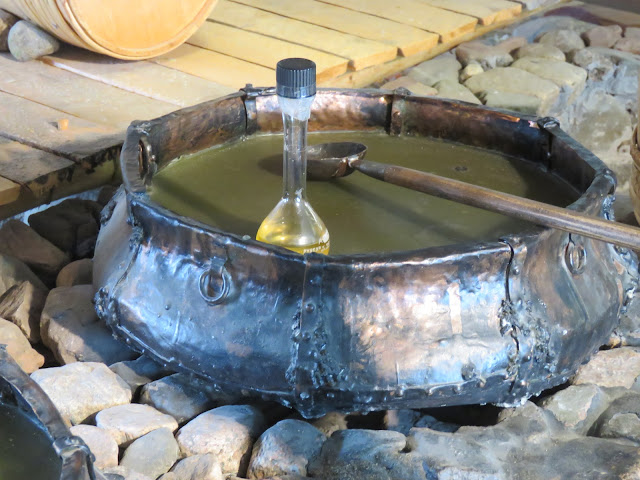Sep 12 Day 3: Port au Choix to L'Anse au Clair, NL
WEATHER Foggy in Newfoundland then sunshine
Board the ferry from St. Barbe to cross the Strait of Belle Isle to Labrador. Continue to Red Bay National Historic Site, a UNESCO World Heritage Site, where the Basques had a whaling station in the 16th century. This mystical place takes the essence of Labrador coastal living and transposes it onto a tapestry of rich culture and history. Spend the night in Labrador. (Breakfast, Dinner)
Day 3 Northern Light Inn - L'Anse au Clair, Newfoundland & Labrador
We have an hour’s drive to St. Barbe to catch the ferry to Labrador by way of Quebec. This makes it an inter-provincial ferry thereby getting funds from the federal government.
St. Barbe – Blanc Sablon (Strait of Belle Isle Area)
MV Qajaq W - pronounced Kayak
Automobiles: 120 vehicles, including 8 tractor trailers
Passengers: 300
Crossing Times:
St. Barbe to Blanc Sablon: 1 hour 45 minutes (36 km)
Once we are aboard, 1 hour and 45 minutes, I did some blog writing and sorted some photos. The crossing was gentle although you did need to hold the handrail if you walked anywhere.
Very cute graphics.
We go to L’Anse au Clair (our night time destination) to offload the luggage so it will be in our rooms upon return.
RED BAY NATIONAL HISTORIC SITE
During the mid-16th century, large numbers of right and bowhead whales drew whalers from the Basque region of Spain and France to the Strait of Belle Isle, where they established a major whaling port at Red Bay. For some 70 years, Basque whalers made the dangerous, month-long journey across the Atlantic to hunt whales and produce the oil that lit the lamps of Europe.
See original Basque artifacts, remains, and restored chalupa at this national historic site and World Heritage Site.
Day 3 Northern Light Inn - L'Anse au Clair, Newfoundland & Labrador
We had to be at the ferry an hour before sailing.
St. Barbe – Blanc Sablon (Strait of Belle Isle Area)
MV Qajaq W - pronounced Kayak
Automobiles: 120 vehicles, including 8 tractor trailers
Passengers: 300
Crossing Times:
St. Barbe to Blanc Sablon: 1 hour 45 minutes (36 km)
While we had great weather, St. John's was being hammered by tropical storm Earl.
We disembark in Quebec at Blanc Sablon and drive to the Labrador border.
RED BAY NATIONAL HISTORIC SITE
During the mid-16th century, large numbers of right and bowhead whales drew whalers from the Basque region of Spain and France to the Strait of Belle Isle, where they established a major whaling port at Red Bay. For some 70 years, Basque whalers made the dangerous, month-long journey across the Atlantic to hunt whales and produce the oil that lit the lamps of Europe.
See original Basque artifacts, remains, and restored chalupa at this national historic site and World Heritage Site.
As I was taking this photo a woman walked over and said "I saw you on your computer this morning, I was wondering if you could help me with my Apple phone", I explained that I didn't really know Apple products." She said her gentleman friend said she was a Luddite, and didn't like Apple.
Mural shows how much bigger the whale is than the little boat the Vikings used.
Explaining how the whale oil is extracted.
In wooden ships built with large cargo holds to accommodate sometimes up to 2000 barrels of whale oil, the whalers came in search of North Atlantic and Greenland Right whales. During the peak whaling periods of the 1550s and 60s there were upwards of a thousand men whaling out of Red Bay alone. A barrel of oil could fetch high prices on the market during peak periods and ship owners and outfitters could pay their expenses, pay the crew and make a good profit in the meantime. Whale oil was a valuable commodity in Europe during that time because it was a brighter burning lamp oil and was a serviceable lubricant for leather products and an additive for paints, varnishes, and soap.We got to smell it and it wasn't vile.
Karen showed us a photo from May 2022 of a snow storm in Red Bay and the houses are buried.
The bottom of the trees are bare due to the salt air and the amount of snow they get.
For convenience, trees are cut in winter for the following year's firewood. Since every family owns a snowmobile, hauling the wood from the cutting location to storage is much easier with a snowmobile-pulled sled. And these are stored along the roadside also.
Our resting spot for the night in L'Anse au Clair.











































A fascinating landscape
ReplyDeleteWow! I'm really enjoying your recaps
ReplyDeleteThanks, Beth. They are shorter than I would like but I am also way behind. Been so busy.
Delete